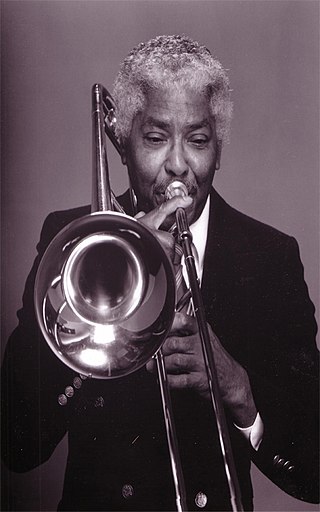Related Research Articles
Jerome Richardson was an American jazz musician and woodwind player. He played the soprano saxophone, alto saxophone, tenor saxophone, baritone saxophone, bass saxophone, soprano clarinet, alto clarinet, bass clarinet, piccolo, western concert flute, soprano flute, alto flute, tenor flute, and bass flute. He played with Charles Mingus, Lionel Hampton, Billy Eckstine, The Thad Jones/Mel Lewis Orchestra, Kenny Burrell, and later with Earl Hines' small band.

Barney Kessel was an American jazz guitarist. Known in particular for his knowledge of chords and inversions and chord-based melodies, he was a member of many prominent jazz groups as well as a "first call" guitarist for studio, film, and television recording sessions. Kessel was a member of the group of session musicians informally known as the Wrecking Crew.

Mitchell Herbert Ellis was an American jazz guitarist. During the 1950s, he was in a trio with pianist Oscar Peterson.

Sonny Stitt was an American jazz saxophonist of the bebop/hard bop idiom. Known for his warm tone, he was one of the best-documented saxophonists of his generation, recording more than 100 albums. He was nicknamed the "Lone Wolf" by jazz critic Dan Morgenstern because of his tendency to rarely work with the same musicians for long despite his relentless touring and devotion to jazz. Stitt was sometimes viewed as a Charlie Parker mimic, especially earlier in his career, but gradually came to develop his own sound and style, particularly when performing on tenor saxophone and even occasionally baritone saxophone.

Beryl Cyril "Jack" Sheldon Jr. was an American singer and actor. He was a member of the band on The Merv Griffin Show and participated in episodes of the educational music television series Schoolhouse Rock!, where he became known for his distinctive voice.
William Thomas "Keter" Betts was an American jazz double bassist.
Discography for jazz double-bassist and cellist Ray Brown.

The London House was a jazz club and restaurant in Chicago located at the corner of Wacker Drive and Michigan Avenue, in the London Guaranty and Accident Company Building, 360 N. Michigan Ave. It was one of the foremost jazz clubs in the country, once home to successful jazz artists including Oscar Peterson, Ramsey Lewis, Bill Evans, Dave Brubeck, Marian McPartland, Dinah Washington, Cannonball Adderley, Erroll Garner, Ahmad Jamal, Nancy Wilson, Barbara Carroll and Bobby Short. On the occasion of its 20th anniversary in November 1966, Frank Sinatra Jr. headlined the club in his Chicago debut.

Edwin Thomas "Ed" Shaughnessy was a swing music and jazz drummer long associated with Doc Severinsen and a member of The Tonight Show Band on The Tonight Show Starring Johnny Carson.
James "Osie" Johnson was a jazz drummer, arranger and singer.

William Randall Henderson was an American television and film actor, and jazz singer.

James Milton Cleveland was an American jazz trombonist born in Wartrace, Tennessee.
Carl Perkins was an American jazz pianist.

Charles Lawrence Persip, known as Charli Persip and formerly as Charlie Persip, was an American jazz drummer.
Joseph Rupert Benjamin was an American jazz bassist.

Joseph Barry Galbraith was an American jazz guitarist.

Affinity is a 1962 studio album by the Oscar Peterson Trio.

Travelin' On is an album by the jazz pianist Oscar Peterson and his trio, released in 1968. It was recorded during the same sessions as Mellow Mood. It was the sixth part of Peterson's Exclusively for My Friends series.
"By Myself" is a 1937 jazz standard. It was written by Arthur Schwartz and Howard Dietz.
Pat Moran is an American jazz pianist.
References
- Footnotes
- ↑ according to 1940 United States Federal Census
- ↑ An Unsung Cat: The Life and Music of Warne Marsh - Page 108 Safford Chamberlain · 2004
- 1 2 The Encyclopedia Of Jazz - Leonard Feather, reprint 1960 page 222
- ↑ two photos feature Gammage with Jack Sheldon in photo book Jazz Seen - William Claxton, page 30 and 122
- ↑ LA musician Lanny Aplanalp recalled seeing them live prior Gammage joining Oscar Peterson, on a Facebook post retrieved oct.2, 2021.
- ↑ Oscar Peterson - "A jazz odyssey - the life of Oscar Peterson -- Peterson, Oscar; Palmer, Richard, · 2002
- ↑ Oscar Peterson: The Will to Swing - Page 143 Gene Lees 2000
- ↑ St. Louis Jazz: A History - Page 84 Dennis C. Owsley · 2019
- ↑ The Last Balladeer: The Johnny Hartman Story - Page 298 Gregg Akkerman · 2012
- ↑ The Village Voice · 16 oct. 1969 · Journal page 80
- ↑ Myers, Marc (3 November 2014). "Now Forgotten, Gary McFarland Introduced Jazz to Pop-Rock". Wsj.com. Retrieved 23 November 2021.
- ↑ "Welcome | This is Gary McFarland". Thisisgarymcfarland.com. Retrieved 23 November 2021.
- ↑ According to Jimmy Cobb in 2010, "he didn't like" that type of music. cited in Jazz and Justice: Racism and the Political Economy of the Music page 371 - Gerald Horne · 2019
- ↑ Oscar Peterson - "A jazz odyssey - the life of Oscar Peterson -- Peterson, Oscar; Palmer, Richard, · 2002
- ↑ The Encyclopedia Of Jazz - Leonard Feather, reprint 1960 page 221
- General references